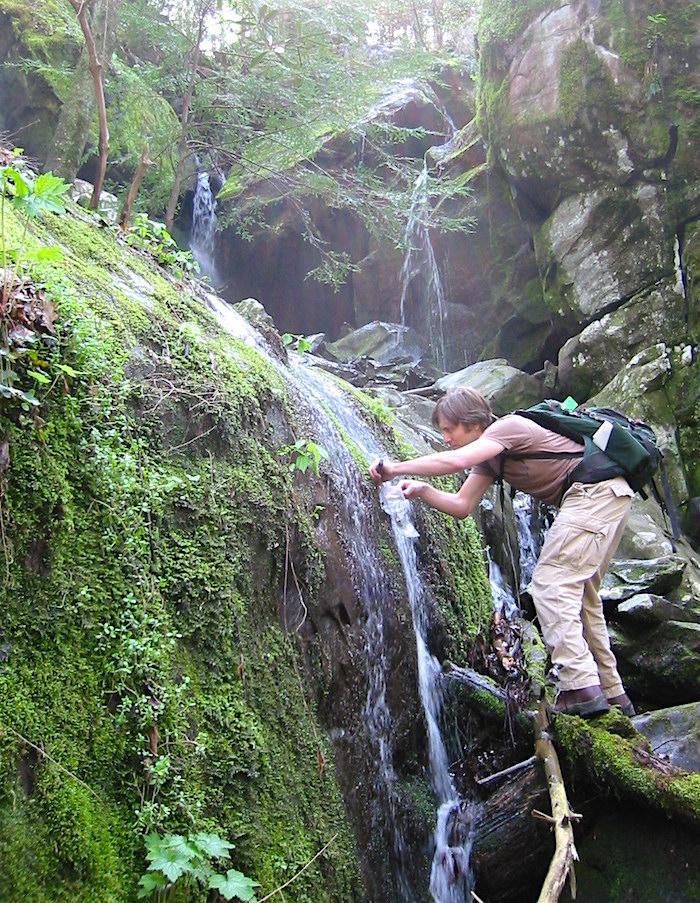
Collecting algae in Great Smoky Mountains National Park as part of the all taxa biodiversity inventory/NPS
It was not quite a decade ago that I traveled to Great Smoky Mountains National Park to better understand efforts there to track down every species that calls the park's rumpled landscape home. At the time the list of previously unknown species that were discovered had reached more than 900. Today that number has grown to nearly 1,000.
That numerical growth in the past eight years since my visit my not seem great, but when you focus on the fact that these were species previously unknown to science, well, it's easier to appreciate the significance of the work done with the help of the nonprofit Discover Life in America organization. As I wrote in a 2010 article for Audubon Magazine:
Often veiled in vapory tendrils, the park has demonstrated that we don’t know quite as much about our resident life-forms as we might think. Since Great Smoky launched its All Taxa Biological Inventory (ATBI) in 1998, at least 907 species new to science and more than 6,500 species previously undetected in the park have been snared, netted, scooped, trapped, and observed by an array of more than 1,000 biologists, entomologists, taxonomists, botanists, and other “ologists.” Armed with bug nets, funnel traps, light traps, and climbing gear to both ascend into forest canopies and descend into caves, degreed scientists and volunteer “citizen scientists” have catalogued thousands of species, big and small, known and previously unknown, and all with ecological roles in the park.
Now, celebrating two decades of searching for species in the park, nearly 20,000 species have been catalogued.
"Some of the more surprising new records include species of well-studied groups like mammals and vascular plants," a park release notes. "Some of the new species to science found during the (All Taxa Biodiversity Inventory) include 31 moths, 41 spiders, 78 algae, 64 beetles, 29 crustaceans, 58 fungi, 21 bees and their relatives, 18 tardigrades (known as waterbears), and 270 bacteria. With collection records from every corner of the park, managers now have a much better understanding of what species exist and what environmental conditions they require."
Through the years, the park and DLIA have hosted more than 1,000 researchers from 150 different universities, museums, and institutions in the United States and around the world, according to park staff. Numerous ATBI-related education events and workshops have been held since 1998, involving over 200,000 students and 6,500 teachers. More than 1,000 volunteers have been trained by DLIA in citizen science workshops and have contributed over 60,000 volunteer hours toward this project. In addition to the park and DLIA, the Friends of the Smokies and Great Smoky Mountains Association have significantly contributed to this ATBI through financial support.
“At the heart of this project are the scientists, park staff, and volunteers who fan out across the park on a regular basis to dig in the leaf litter, wade in the streams, and look under rocks for anything and everything alive,” said Todd Witcher, executive director of DLIA. “They are the true heroes of the Smokies and the remarkable number of new species discoveries is a testament to their passion and perseverance.”
The Appalachian Mountains are among the oldest mountains in the world. Through the eons, forces such as wind, rain, freezing, and thawing eroded the peaks. Although glaciers did not reach this far south, their influence on the climate combined with the range of elevations and the southwest to northeast orientation of these mountains accounts for the striking variety of living things found in the park. The biological diversity of the Smokies was the impetus for conducting the ATBI, and the project has now grown to be the largest sustained natural history inventory in the United States.
This scientific effort has produced a baseline for one of the most diverse ecosystems in the United States. Park managers now have a better understanding of the resources, and can better predict how changing conditions in the future may impact them. ATBI information also provides a foundation allowing for future park managers to make better-informed decisions. -- National Park Service



Add comment